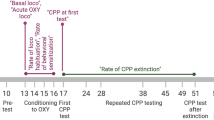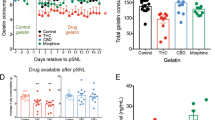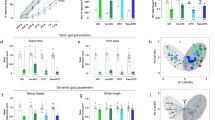Abstract
Tramadol is an opioid-like analgesic with relatively mild side effects. Because it is inexpensive and is not classified as a controlled substance by the US federal government, the authors wanted to evaluate its applicability as a practical and effective analgesic in male Sprague Dawley rats. They measured the efficacy of four dosages (4, 12.5, 25 or 50 mg tramadol per kg body weight) and three routes of administration (per os (p.o.) in a flavored gelatin cube, subcutaneous (s.c.) or intraperitoneal (i.p.)) using the hot-plate test and the tail-flick test, which were carried out 1 week apart. Rats that were dosed p.o. were given flavored gelatin cubes without tramadol on the 2 d before testing to help them become acclimated to the gelatin, in an effort to increase the likelihood that they would consume the gelatin on the testing day. Results from the hot-plate and tail-flick tests for rats that were given tramadol p.o. were similar before and after administration, regardless of tramadol dosage, suggesting that this route of administration was not effective. The s.c. route of administration was effective at dosages of 25 mg and 50 mg tramadol per kg body weight, although these dosages also resulted in sedation and skin lesions. The i.p. route of administration was also effective at dosages of 12.5 mg, 25 mg and 50 mg tramadol per kg body weight, though sedation was observed at dosages of 25 mg and 50 mg per kg body weight. Intraperitoneal administration of 12.5 mg tramadol per kg body weight had no notable side effects, and the authors plan to further study this dosage and route of administration in a rodent surgical model of pain.
This is a preview of subscription content, access via your institution
Access options
Subscribe to this journal
We are sorry, but there is no personal subscription option available for your country.
Buy this article
- Purchase on Springer Link
- Instant access to full article PDF
Prices may be subject to local taxes which are calculated during checkout




Similar content being viewed by others
References
Wilson, S.G. & Mogil, J.S. Measuring pain in the (knockout) mouse: big challenges in a small mammal. Behav. Brain Res. 125, 65–73 (2001).
Kona-Boun, J.J., Silim, A. & Troncy, E. Immunologic aspects of veterinary anesthesia and analgesia. J. Am. Vet. Med. Assoc. 226, 355–363 (2005).
McGuire, L. et al. Pain and wound healing in surgical patients. Ann. Behav. Med. 31, 165–172 (2005).
Interagency Research Animal Committee. U.S. Government Principles for the Utilization and Care of Vertebrate Animals Used in Testing, Research, and Training (Interagency Research Animal Committee, 1985) http://grants.nih.gov/grants/olaw/references/phspol.htm#USGovPrinciples.
Institute for Laboratory Animal Research. Guide for the Care and Use of Laboratory Animals 6–68 (National Academy Press, Washington, DC, 1996).
Raffa, R. et al. Opioid and nonopioid components independently contribute to the mechanism of action of tramadol, an 'atypical' opioid analgesic. J. Pharmacol. Exp. Ther. 260, 275–285 (1992).
Kayser, V., Besson, J.M. & Guilbaud, G. Evidence for a noradrenergic component in the antinociceptive effect of the analgesic agent tramadol in an animal model of clinical pain, the arthritic rat. Eur. J. Pharmacol. 224, 83–88 (1992).
Raffa, R.B. & Friderichs, E. The basic science aspect of tramadol hydrochloride. Pain Rev. 3, 249–271 (1996).
Negro, S., Martin, A., Azuara, M.L., Sánchez, Y. & Barcia, E. Stability of tramadol and haloperidol for continuous subcutaneous infusion at home. J. Pain Symptom Manage. 30, 192–199 (2005).
Uyar, M., Onal, A., Urar, M., Dogru, A. & Soykan, N. The antinociceptive effect of tramadol-venlafaxine combination on the paw withdrawal threshold in a rat model of neuropathic pain. Methods Find. Exp. Clin. Pharmacol. 25, 361–365 (2003).
Grond, S. & Sablotzki, A. Clinical pharmacology of tramadol. Clin. Pharmacokinet. 43, 879–923 (2004).
Affaitati, G. et al. Effects of tramadol on behavioural indicators of colic pain in a rat model of ureteral calculosis. Fundam. Clin. Pharmacol. 16, 23–30 (2002).
Garlicki, J., Dorazil-Dudzik, M., Wordliczek, J. & Przewlocka, B. Effect of intraarticular tramadol administration in the rat model of knee joint inflammation. Pharmacol. Rep. 58, 672–679 (2006).
Xie, H. et al. Involvement of serotonin 2A receptors in the analgesic effect of tramadol in mono-arthritic rats. Brain Res. 1210, 76–83 (2008).
Hama, A. & Sagen, J. Altered antinociceptive efficacy of tramadol over time in rats with painful peripheral neuropathy. Eur. J. Pharmacol. 559, 32–37 (2007).
Hampshire, V.A. & Davis, J.A. Postprocedural care of commonly utilized research animal subjects. in Anesthesia and Analgesia in Laboratory Animals 2nd edn. (eds. Fish, R.E., Brown, M.J., Danneman, P.J. & Karas, A.Z.) 231–233 (Academic, San Diego, 2008).
Flecknell, P.A., Roughan, J.V. & Stewart, R. Use of oral buprenorphine ('buprenorphine jello') for postoperative analgesia in rats—a clinical trial. Lab. Anim. 33, 169–174 (1999).
Cooper, D.M., Deong, D. & Gillett, C.S. Analgesic efficacy of acetaminophen and buprenorphine administered in the drinking water of rats. Contemp. Top. Lab Anim. Sci. 36, 58–62 (1997).
Martin, L.B.E., Thompson, A.C., Martin, T. & Kristal, M.B. Analgesic efficacy of orally administered buprenorphine in rats. Comp. Med. 51, 43–48 (2001).
Bihum, C. & Bauck, L. Basic anatomy, physiology, behavior, and husbandry and clinical techniques. in Ferrets, Rabbits, and Rodents, Clinical Medicine and Surgery 2nd edn. (eds. Quesenberry, K. & Carpenter, J.W.) 286–298 (Saunders, St. Louis, 2004).
Harkness, J.E. & Wagner, J.E. Biology and Medicine of Rabbits and Rodents 4th edn. 100 (Williams and Wilkins, Baltimore, 1995).
Lemberg, K.K. et al. Antinociception by spinal and systemic oxycodone: why does the route make a difference? In vitro and in vivo studies in rats. Anesthesiology 105, 801–812 (2006).
Fischer, B.D. & Dykstra, L.A. Interactions between an N-methyl-D-aspartate antagonist and low-efficacy opioid receptor agonists in assays of schedule-controlled responding and thermal nociception. J. Pharmacol. Exp. Ther. 318, 1300–1306 (2006).
Cloutier, S. & Newberry, R.C. Tickled pink: Playful handling as social enrichment for laboratory rats. AWI Quarterly 58, 24–25 (2009).
Roberts, L. & Dyson, M. An alternative method of rat restraint. TechTalk 13, 1 (2008).
Espejo, E.F., Stinus, L., Cador, M. & Mir, D. Effects of morphine and naloxone on behaviour in the hot plate test: an ethopharmacological study in the rat. Psychopharmacology (Berl) 113, 500–510 (1994).
Boules, M., Shaw, A., Liang, Y., Barbut, D. & Richelson, E. NT69L, a novel analgesic, shows synergy with morphine. Brain Res. 1294, 22–28 (2009).
Lomas, L.M., Terner, J.M. & Picker, M.J. Sex differences in NMDA antagonist enhancement of morphine antihyperalgesia in a capsaicin model of persistent pain: comparisons to two models of acute pain. Pharmacol. Biochem. Behav. 89, 127–136 (2008).
Thomsen, M. et al. Involvement of Y(5) receptors in neuropeptide Y agonist-induced analgesic-like effect in the rat hot plate test. Brain Res. 1155, 49–55 (2007).
Madgulkar, A.R., Bhalekar, M.R. & Padalkar, R.R. Formulation design and optimization of novel taste masked mouth-dissolving tablets of tramadol having adequate mechanical strength. AAPS PharmSciTech 10, 574–581 (2009).
Lintz, W., Barth, H., Osterloh, G. & Schmidt-Böthelt, E. Bioavailability of enteral tramadol formulations. 1st communication: capsules. [German]. Arzneimittelforschung 36, 1278–1283 (1986).
Lee, C.R., McTavish, D. & Sorkin, E.M. Tramadol. A preliminary review of its pharmacodynamic and pharmacokinetic properties, and therapeutic potential in acute and chronic pain states. Drugs 46, 313–340 (1993).
Liao, S., Hill, J.F. & Nayak, R.K. Pharmacokinetics of tramadol following single and multiple oral doses in man (abstract). Pharm. Res. 9 Suppl., 308 (1992).
Parasrampuria, R., Vuppugalla, R., Elliott, K. & Mehvar, R. Route-dependent stereoselective pharmacokinetics of tramadol and its active O-demethylated metabolite in rats. Chirality 19, 190–196 (2007).
Liu, H.C., Zhang, X.J., Yang, Y.Y., Wang, N. & Hou, Y.N. Stereoselectivity in renal clearance of trans-tramadol and its active metabolite, trans-O-demethyltramadol. Acta Pharmacol. Sin. 23, 83–86 (2002).
Wu, W.N., McKown, L.A., Codd, E.E. & Raffa, R.B. In vitro metabolism of the analgesic agent, tramadol-N-oxide, in mouse, rat, and human. Eur. J. Drug Metab. Pharmacokinet. 27, 193–197 (2002).
Lintz, W., Erlaçin, S., Frankus, E. & Uragg, H. Biotransformation of tramadol in man and animal. [German]. Arzneimittelforschung 31, 1932–1943 (1981).
Liu, H., Jin, S. & Wang, Y. Gender-related differences in pharmacokinetics of enantiomers of trans-tramadol and its active metabolite, trans-O-demethyltramadol, in rats. Acta Pharmacol. Sin. 24, 1265–1269 (2003).
Loram, L.C., Mitchell, D., Skosana, M. & Fick, L.G. Tramadol is more effective than morphine and amitriptyline against ischaemic pain but not thermal pain in rats. Pharmacol. Res. 56, 80–85 (2007).
Dhasmana, K.M., Banerjee, A.K., Rating, W. & Erdmann, W. Analgesic effect of tramadol in the rat. Acta Pharmacol. Sin. 10, 289–293 (1989).
Cartmell, S.M., Gelgor, L. & Mitchell, D. A revised rotarod procedure for measuring the effect of antinociceptive drugs on motor function in the rat. J. Pharmacol. Methods 26, 149–159 (1991).
Hargis, A.M. & Ginn, P.E. The integument: Injection site reactions. in Pathologic Basis of Veterinary Disease 4th edn. (eds. McGavin, M.D. & Zachary, J.F.) 1167–1168 (Mosby Elsevier, St. Louis, 2007).
Engelhardt, J.A. Predictivity of animal studies for human injection site reactions with parenteral drug products. Exp. Toxicol. Pathol. 60, 323–327 (2008).
King, D.L. & Appelbaum, J.R. Effect of trials on “emotionality” behavior of the rat and mouse. J. Comp. Physiol. Psychol. 85, 186–194 (1973).
Grandin, T., Dodman, N. & Shuster, L. Effect of naltrexone on relaxation induced by flank pressure in pigs. Pharmacol. Biochem. Behav. 33, 839–842 (1989).
Grandin, T. & Johnson, C. Animal feelings: Feelings from my squeeze machine. in Animals in Translation 58–62 (Scribner, New York, 2005).
Bamigbade, T.A. & Langford, R.M. Tramadol hydrochloride: an overview of current use. Hosp. Med. 59, 373–376 (1998).
Acknowledgements
We thank Danielle Waxer, Page Myers, James Clark, Sandy Hackney, Jenetta Jackson and Keisha Chavis for their assistance and support of the research and care of the animals. We thank Dr. Larry Wright for assistance in literature evaluation. We thank Dr. Sheryl Moy, Dr. Greg Travlos and Dr. Gregory Cannon for their extensive reviews of the manuscript. This research was supported by the Intramural Research Program of the National Institutes of Health and the National Institute of Environmental Health Sciences.
Author information
Authors and Affiliations
Corresponding author
Ethics declarations
Competing interests
The authors declare no competing financial interests.
Rights and permissions
About this article
Cite this article
Cannon, C., Kissling, G., Hoenerhoff, M. et al. Evaluation of dosages and routes of administration of tramadol analgesia in rats using hot-plate and tail-flick tests. Lab Anim 39, 342–351 (2010). https://doi.org/10.1038/laban1110-342
Received:
Accepted:
Published:
Issue Date:
DOI: https://doi.org/10.1038/laban1110-342
This article is cited by
-
Post craniotomy pain management in Copenhagen rat by intraperitoneal or oral dosage of Tramadol: a comparative evaluation
Scientific Reports (2023)
-
Phytochemical Analysis and Evaluation of the Antioxidant, Anti-Inflammatory, and Antinociceptive Potential of Phlorotannin-Rich Fractions from Three Mediterranean Brown Seaweeds
Marine Biotechnology (2018)
-
Evaluation of buprenorphine hydrochloride Pluronic® gel formulation in male C57BL/6NCrl mice
Lab Animal (2016)
-
Analgesic effects of tramadol, carprofen or multimodal analgesia in rats undergoing ventral laparotomy
Lab Animal (2011)



